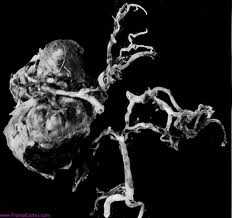
最新一期的《神经外科学》杂志上[Neurosurgery 2012 Nov 30]发表的的一项研究表明:对于不能行夹闭术的巨型大脑中动脉动脉瘤,颅外-颅内动脉搭桥是一项安全可行的治疗选择。
菲尼克斯圣约瑟夫医院与医疗中心,亚利桑那州Robert Spetzler教授及其研究小组称,“巨型动脉瘤进展率高,自然病程差,一旦确诊就应进行积极治疗。”但是,他们强调,由于存在动脉瘤复发可能,患者需要“终生监测”。在他们所研究的16例患者的平均58.4个月随访期间(所有动脉瘤直径均大于2.5 cm)。3例患者需再行介入治疗。在需要治疗的患者中,术后血管造影检查发现残余瘤证据者2例,行弹簧圈填塞再治疗2例,再夹闭治疗1例。再治疗未引发疾病或死亡。
Spetzler教授说,“该治疗策略背后的逻辑很简单,搭桥手术重建了动脉瘤周围区域血管,动脉瘤血流减少促进血栓形成。当血管在动脉瘤近心端结扎时,腔内压力下降,动脉瘤破裂风险降低,逆行血流减少则导致血栓形成。”
搭桥手术时,研究人员最常使用颞浅动脉进行搭桥,部分患者则采用桡动脉移植。搭桥术后,研究人员阻断载瘤血管,近心端9例,远心端4例,动脉瘤孤立术1例。
研究人员说,“在可能情况下,我们宁愿阻断近端血管,因为理论上,它在减少动脉瘤破裂风险方面占有优势。不过,当近端血流暴露受限,或动脉瘤近端部分有危险分支出现时,可选择载瘤血管远端阻断,从而导致动脉瘤栓塞和夹闭。”
手术后,除1例患者外,其余搭桥均通畅,12例患者(75%)动脉瘤完全阻断。无患者死亡,但有5例患者出现围手术期并发症,其中有症状梗死3例,分流依赖性脑积水2例。长期结果总体良好,15例患者格拉斯哥结局量表(GOS)得分为4或5。只有1例GOS得分为3,该患者因围手术期梗塞(尽管搭桥通畅)出现持续性缺血。
与脑动脉瘤相关的拓展阅读:

Background
Giant middle cerebral artery (MCA) aneurysms pose management challenges.
Objective
To review the outcomes of patients with giant MCA aneurysms not amenable to clipping or vessel reconstruction treated with extracranial-intracranial (EC-IC) bypass and vessel sacrifice.
Methods
We retrospectively reviewed a database of aneurysms treated at our institution between 1983 and 2011.
Results
Sixteen patients (11 males, 5 females) were identified. There were 10 saccular, 4 fusiform, and 2 serpentine aneurysms. The aneurysms predominantly involved the M1 segment in 5 cases, M2 in 9 cases, and both M1 and M2 in 2 cases. The EC-IC bypasses performed included 13 STA-MCA, 1 saphenous vein graft (SVG-MCA), and 2 radial artery grafts (RAG-MCA). Postoperative bypass patency rate was 93.8% (15/16). There were three cerebrovascular accidents (18.8%), but no perioperative deaths (0% mortality). The mean follow-up was 58.4 months (range, 1-265; median, 23.5 months). In 75% (12/16) of cases the aneurysms were occluded successfully. A small residual was noted in three cases using this treatment strategy and they were retreated. In a fourth case treated with partial distal occlusion, reduced flow through the aneurysm was noted postoperatively, but the patient did not undergo further treatment. The mean modified Rankin scale (mRS) and mean Glasgow Outcome Scale (GOS) scores at last follow-up were 1.6 (range 1-4, median 1) and 4.8 (range 3-5, median 5), respectively.
Conclusion
Giant MCA aneurysms are challenging lesions. EC-IC bypass with parent vessel occlusion can provide a durable form of treatment with acceptable rates of morbidity and mortality.
来源:NEUROSURGERY
版权声明:
本网站所有注明“来源:梅斯医学”或“来源:MedSci原创”的文字、图片和音视频资料,版权均属于梅斯医学所有,非经授权,任何媒体、网站或个人不得转载,授权转载时须注明“来源:梅斯医学”。本网所有转载文章系出于传递更多信息之目的,且明确注明来源和作者,不希望被转载的媒体或个人可与我们联系,我们将立即进行删除处理。同时转载内容不代表本站立场。
在此留言

